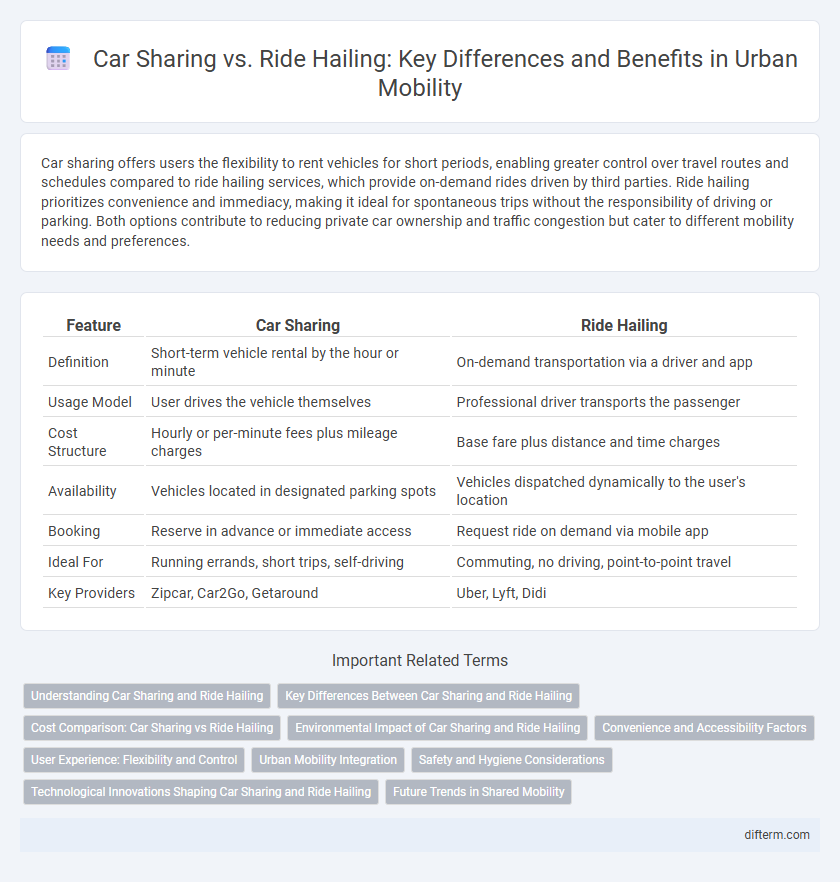Car sharing offers users the flexibility to rent vehicles for short periods, enabling greater control over travel routes and schedules compared to ride hailing services, which provide on-demand rides driven by third parties. Ride hailing prioritizes convenience and immediacy, making it ideal for spontaneous trips without the responsibility of driving or parking. Both options contribute to reducing private car ownership and traffic congestion but cater to different mobility needs and preferences.
Table of Comparison
| Feature | Car Sharing | Ride Hailing |
|---|---|---|
| Definition | Short-term vehicle rental by the hour or minute | On-demand transportation via a driver and app |
| Usage Model | User drives the vehicle themselves | Professional driver transports the passenger |
| Cost Structure | Hourly or per-minute fees plus mileage charges | Base fare plus distance and time charges |
| Availability | Vehicles located in designated parking spots | Vehicles dispatched dynamically to the user's location |
| Booking | Reserve in advance or immediate access | Request ride on demand via mobile app |
| Ideal For | Running errands, short trips, self-driving | Commuting, no driving, point-to-point travel |
| Key Providers | Zipcar, Car2Go, Getaround | Uber, Lyft, Didi |
Understanding Car Sharing and Ride Hailing
Car sharing allows users to rent vehicles for short periods, providing flexible, self-driven transportation typically accessed through mobile apps and promoting reduced car ownership. Ride hailing connects passengers with drivers via digital platforms, offering on-demand, door-to-door rides without the need for users to drive themselves. Both models contribute to urban mobility by increasing convenience and optimizing vehicle usage, though car sharing emphasizes user autonomy while ride hailing centers on service-based transportation.
Key Differences Between Car Sharing and Ride Hailing
Car sharing allows users to rent vehicles for short periods, offering flexibility and cost savings for planned trips and extended use, while ride hailing provides on-demand transportation by connecting passengers with drivers through apps. Key differences include vehicle ownership, as car sharing involves self-driving rented cars, whereas ride hailing relies on drivers operating personal or commercial vehicles. Pricing models also vary, with car sharing typically charging hourly or mileage rates and ride hailing using dynamic pricing based on real-time demand and trip distance.
Cost Comparison: Car Sharing vs Ride Hailing
Car sharing typically offers lower costs for short-term usage and predictable trip durations, with rates based on hourly or per-minute pricing and sometimes including fuel and insurance. Ride hailing services usually charge higher fees that combine base fares, distance, and surge pricing, making them more expensive for frequent or longer trips. Users seeking economical options for local travel often prefer car sharing, while ride hailing provides convenience despite its higher cost.
Environmental Impact of Car Sharing and Ride Hailing
Car sharing significantly reduces carbon emissions by decreasing the total number of vehicles on the road, promoting efficient use of resources and lowering individual car ownership rates. Ride hailing services, while convenient, often increase traffic congestion and emissions due to deadheading--when drivers circulate without passengers--and increased trip distances. Studies indicate that shifting urban mobility habits toward car sharing can lead to substantial environmental benefits compared to the higher emissions footprint associated with ride hailing platforms.
Convenience and Accessibility Factors
Car sharing offers users flexible access to vehicles parked nearby, allowing for spontaneous trips without a driver, which enhances convenience in densely populated urban areas. Ride hailing provides door-to-door service with minimal wait times, making it highly accessible for individuals without driver's licenses or those preferring not to drive. Both models improve urban mobility but cater to different convenience preferences: car sharing emphasizes self-driven flexibility, while ride hailing focuses on hassle-free, on-demand transportation.
User Experience: Flexibility and Control
Car sharing offers users greater flexibility and control by enabling self-driving at their own pace and schedule, often with lower costs for short trips. Ride hailing provides convenience through on-demand driver service, but users have less control over routes and timing. Both models enhance urban mobility, yet car sharing prioritizes user autonomy while ride hailing emphasizes immediate accessibility.
Urban Mobility Integration
Car sharing and ride hailing both enhance urban mobility integration by reducing private car ownership and alleviating congestion in city centers. Car sharing promotes flexible vehicle access for short-term use, complementing public transit networks and encouraging multimodal travel. Ride hailing provides on-demand, door-to-door service that bridges gaps in public transportation, supporting first-mile and last-mile connectivity for urban commuters.
Safety and Hygiene Considerations
Car sharing offers enhanced hygiene control through user-managed vehicle cleaning protocols, reducing exposure to unknown drivers compared to ride hailing, where multiple passengers share a driver-operated vehicle with variable sanitation standards. Safety in car sharing is bolstered by the ability to inspect and sanitize the car before use, while ride hailing relies heavily on driver conduct and company-enforced safety measures such as background checks and in-app emergency features. Both models continuously evolve safety technologies, but personal control over vehicle cleanliness remains a significant advantage for car sharing in mitigating health risks.
Technological Innovations Shaping Car Sharing and Ride Hailing
Technological innovations such as AI-powered fleet management and real-time data analytics are revolutionizing car sharing and ride hailing services by optimizing routes, reducing wait times, and enhancing user experience. IoT integration enables seamless vehicle tracking and maintenance alerts, increasing operational efficiency across platforms. Advanced mobile applications with predictive algorithms facilitate dynamic pricing and demand forecasting, transforming the landscape of urban mobility.
Future Trends in Shared Mobility
Car sharing is projected to expand with increased integration of electric vehicles and autonomous technology, promoting sustainability and reducing urban congestion. Ride hailing services are evolving through AI-driven route optimization and dynamic pricing models to enhance user convenience and operational efficiency. Future trends indicate a convergence of these shared mobility options into multimodal platforms offering seamless, flexible transportation solutions.
car sharing vs ride hailing Infographic

 difterm.com
difterm.com